Space food
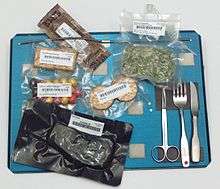
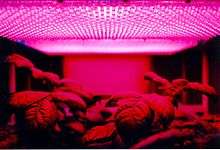
Space food is a type of food product created and processed for consumption by astronauts in outer space. The food has specific requirements of providing balanced nutrition for individuals working in space, while being easy and safe to store, prepare and consume in the machinery-filled weightless environments of manned spacecraft.
In recent years, space food has been used by various nations engaging on space programs as a way to share and show off their cultural identity and facilitate intercultural communication. Although astronauts consume a wide variety of foods and beverages in space, the initial idea from The Man in Space Committee of the Space Science Board in 1963 was to supply astronauts with a formula diet that would supply all the needed vitamins and nutrients.[1]
Early history
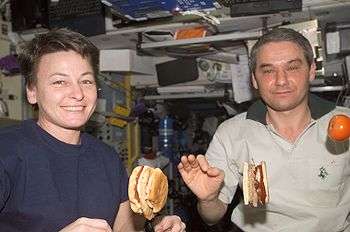
For lunch on Vostok I (1961) Yuri Gagarin ate from three 160 g toothpaste-type tubes, two of which contained servings of puréed meat and one which contained chocolate sauce.
In August 1961, Soviet Cosmonaut Gherman Titov became the first human to experience space sickness on Vostok II; he holds the record for being the first person to vomit in space.[2] According to Lane and Feeback, this event "heralded the need for space flight nutrition."[3]
One of John Glenn's many tasks, as the first American to orbit Earth in 1962, was to experiment with eating in weightless conditions. Some experts had been concerned that weightlessness would impair swallowing. Glenn experienced no difficulties and it was determined that microgravity did not affect the natural swallowing process, which is enabled by the peristalsis of the esophagus.
Astronauts in later Mercury missions (1959–1963) disliked the food that was provided. They ate bite-sized cubes, freeze-dried powders, and tubes of semiliquids. The astronauts found it unappetizing, experienced difficulties in rehydrating the freeze-dried foods, and did not like having to squeeze tubes or collect crumbs.[4] Prior to the mission, the astronauts were also fed low residual launch-day breakfasts, to reduce the chances that they would defecate in flight.[5]
Project Gemini and Apollo (1965–1975)
Several of the food issues from the Mercury missions were addressed for the later Gemini missions (1965–1966). Tubes (often heavier than the foods they contained) were abandoned. Gelatin coatings helped to prevent bite-sized cubes from crumbling. Simpler rehydration methods were developed. The menus also expanded to include items such as shrimp cocktail, chicken and vegetables, toast squares, butterscotch pudding, and apple juice.[4]
The crew of Gemini III sneaked a corned beef sandwich on their spaceflight. Mission Commander Gus Grissom loved corned beef sandwiches, so Pilot John Young brought one along, having been encouraged by fellow astronaut Walter Schirra. However, Young was supposed to eat only approved food, and Grissom was not supposed to eat anything. Floating pieces of bread posed a potential problem, causing Grissom to put the sandwich away (although he did enjoy it)[6] and the astronauts were mildly rebuked by NASA for the act. A congressional hearing was called, forcing the NASA deputy administrator George Mueller to promise no repeats. NASA took special care about what astronauts brought along on future missions.[7][8][9]
Prior to the Apollo program (1968–1975), early space food development was conducted at the US Air Force School of Aerospace Medicine and the Natick Army Labs.[3] The variety of food options continued to expand for the Apollo missions. The new availability of hot water made rehydrating freeze-dried foods simpler, and produced a more appetizing result. The "spoon-bowl" allowed more normal eating practices. Food could be kept in special plastic zip-closure containers, and its moisture allowed it to stick to a spoon.[4]
Apollo 11 (1969)
On Sunday, 20 July 1969, Buzz Aldrin, on the moon, partook of the Presbyterian Christian sacrament of Holy Communion, which had been consecrated by his pastor, the Rev. Dean Woodruff, two weeks prior to the space mission.[10]
I poured the wine into the chalice our church had given me. In the one-sixth gravity of the moon the wine curled slowly and gracefully up the side of the cup. It was interesting to think that the very first liquid ever poured on the moon, and the first food eaten there, were communion elements. —Buzz Aldrin[10]
Aldrin received the Eucharist in the same hour that his local church did on that Sunday Sabbath and he later stated that "I sensed especially strongly my unity with our church back home, and with the Church everywhere".[10]
Skylab (1973–1974)
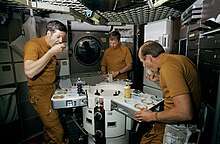
Larger living areas on the Skylab space station (1973–1974) allowed for an on-board refrigerator and freezer, which allowed perishable and frozen items to be stored and made microgravity the primary obstacle.[11]:142–144 When Skylab's solar panels were damaged during its launch and the station had to rely on minimal power from the Apollo Telescope Mount until Skylab 2 crewmembers performed repairs, the refrigerator and freezer were among the systems that Mission Control kept operational.
Menus included 72 items; for the first time about 15% was frozen. Shrimp cocktail and butter cookies were consistent favorites; Lobster Newburg, fresh bread,[12] processed meat products, and ice cream were among other choices. A dining room table and chairs, fastened to the floor and fitted with foot and thigh restraints, allowed for a more normal eating experience. The trays used could warm the food, and had magnets to hold eating utensils and scissors used for opening food containers.[11]:142–144[13]:29 The food was similar to that used for Apollo, but canned for preservation;[12] the crew found it to be better than that of Apollo but still unsatisfying, partially due to food tasting different in space than on Earth.[11]:292–293,308 The frozen foods were the most popular, and they enjoyed spicy foods[13]:130 due to head congestion from weightlessness dulling their senses of taste and smell.[11]:292–293,308 Weightlessness also complicated both eating and cleaning up; crews spent up to 90 minutes a day on housekeeping.[14]
After astronaut requests, NASA bought Paul Masson Rare Cream Sherry for one Skylab mission and packaged some for testing on a reduced gravity aircraft. In microgravity smells quickly permeate the environment and the agency found that the sherry triggered the gag reflex. Concern over public reaction to taking alcohol into space led NASA to abandon its plans, so astronauts drank the purchased supply while consuming their pre-mission special diet.[12]
The astronauts of the Apollo-Soyuz Test Project (1975) received samples of Soviet space food when the combined crew dined together. Among the foods provided by Soyuz 19 were canned beef tongue, packaged Riga bread, and tubes of borscht (beet soup) and caviar. The borscht was labeled "vodka".[15]
Interkosmos (1978–1988)
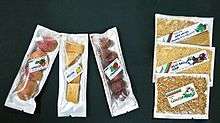
As part of the Interkosmos space program, allies of the Soviet Union have actively participated in the research and deployment of space technologies. The Institute of Cryobiology and Lyophilization (now the Institute of Cryobiology and Food Technology), founded in 1973 as a part of the Bulgarian Academy of Sciences, has since produced space food for the purposes of the program.[16][17] The menu includes traditional Bulgarian dishes such as tarator, sarma, musaka, lyutenitza, kiselo mlyako, dried vegetables and fruits, etc.[18][19]
Modern
Today, fruits and vegetables that can be safely stored at room temperature are eaten on space flights. Astronauts also have a greater variety of main courses to choose from, and many request personalized menus from lists of available foods including items like fruit salad and spaghetti. Astronauts sometimes request beef jerky for flights, as it is lightweight, calorie dense, and can be consumed in orbit without packaging or other changes.
.jpg)
- Chinese: In October 2003, the People's Republic of China commenced their first manned space flight. The astronaut, Yang Liwei, brought along with him and ate specially processed yuxiang pork (simp: 鱼香肉丝; trad: 魚香肉絲), Kung Pao chicken (simp: 宫保鸡丁; trad: 宮保雞丁), and Eight Treasures rice (simp: 八宝饭; trad: 八寶飯), along with Chinese herbal tea.[20] Food made for this flight and the subsequent manned flight in 2007 has been commercialized for sale to the mass market.[21][22]
- Italian: Commercial firms Lavazza and Argotec developed an espresso machine, called ISSpresso, for the International Space Station. It can also brew other hot drinks, such as tea, hot chocolate, and broth. On 3 May 2015, Italian astronaut Samantha Cristoforetti became the first person to drink freshly brewed coffee in space. While the device serves as a quality-of-life improvement aboard the station, it is also an experiment in fluid dynamics in space.[23][24] The brewing machine and drinking cups were specially designed to work with fluids in low gravity.[25]
- Japanese: The Japan Aerospace Exploration Agency (JAXA) have developed traditional Japanese foods and drinks such as matcha, yōkan, ramen, sushi, soups, rice with ume for consumption in orbit.[26] The foods have been produced in collaboration with Japanese food companies such as Ajinomoto, Meiji Dairies, and Nissin Foods.[27]
- Korean: In April 2008, South Korea’s first astronaut, Yi So-yeon, was a crew member on the International Space Station and brought a modified version of Korea's national dish, kimchi. It took three research institutes several years and over one million dollars in funding to create a version of the fermented cabbage dish that was suitable for space travel.[28]
- Russian: On the ISS the Russian crew has a selection of over 300 dishes. An example daily menu can be:[29]
- Breakfast: curds and nuts, mashed potatoes with nuts, apple-quince chip sticks, sugarless coffee and vitamins.
- Lunch: jellied pike perch, borsch with meat, goulash with buckwheat, bread, black currant juice, sugarless tea.
- Supper: rice and meat, broccoli and cheese, nuts, tea with sugar.
- Second supper: dried beef, cashew nuts, peaches, grape juice.
- Swedish: Swedish astronaut Christer Fuglesang was not allowed to bring reindeer jerky with him on board a shuttle mission as it was "weird" for the Americans so soon before Christmas. He had to go with moose instead.[30][31]
NASA's Advanced Food Technology Project (AFT) is currently researching ways to ensure an adequate food supply for long-duration space exploration missions.[32]
Processing
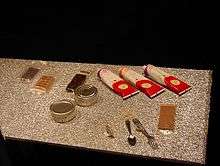
Designing food for consumption in space is an often difficult process. Foods must meet a number of criteria to be considered fit for space. Firstly, the food must be physiologically appropriate. Specifically, it must be nutritious, easily digestible, and palatable. Secondly, the food must be engineered for consumption in a zero gravity environment. As such, the food must be light, well packaged, fast to serve and require minimal cleaning up. (Foods that tend to leave crumbs, for example, are ill-suited for space.) Finally, foods require a minimum of energy expenditure throughout their use; they must store well, open easily and leave little waste behind.
Carbonated drinks have been tried in space, but are not favored due to changes in belching caused by microgravity; without gravity to separate the liquid and gas in the stomach, burping results in a kind of vomiting called "wet burping".[33] Coca-Cola and Pepsi were first carried on STS-51-F in 1985. Coca-Cola has flown on subsequent missions in a specially designed dispenser that utilizes BioServe Space Technologies hardware used for biochemical experiments. Space Station Mir carried cans of Pepsi in 1996.
Beer has also been developed that counteracts the reduction of taste and smell reception in space and reduces the possibility of wet belches (vomiting caused by belching) in microgravity. Produced by Vostok 4-Pines Stout, a parabolic flight experiment validated that the reduced carbonation recipe met the criteria intended for space.[34] Barley harvested from crops grown for several generations in space has also been brought back to Earth to produce beer. While not a space food (it used the same high carbonation 'Earth' recipe), the study did demonstrate that ingredients grown in space are safe for production.[35]
Space bread has proved elusive because of a variety of challenges. By 2012 a method was suggested where dough is leavened by dissolved CO
2 (as opposed to yeast) and cooked by a low-temperature process. This could allow fresh baked bread from bulk ingredients on future spaceflights.[36]
Packaging
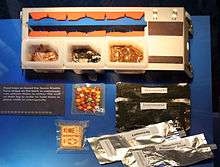
Packaging for space food serves the primary purposes of preserving and containing the food. The packaging, however, must also be light-weight, easy to dispose of and useful in the preparation of the food for consumption. The packaging also includes a bar-coded label, which allows for the tracking of an astronaut's diet. The labels also specify the food's preparation instructions in both English and Russian.[33]
Many foods from the Russian space program are packaged in cans and tins.[37] These are heated through electro-resistive (ohmic) methods, opened with a can-opener, and the food inside consumed directly. Russian soups are hydrated and consumed directly from their packages.[38]
NASA space foods are packaged in retort pouches or employ freeze drying.[37] They are also packaged in sealed containers which fit into trays to keep them in place. The trays include straps on the underside, allowing astronauts to attach the tray to an anchor point such as their legs or a wall surface and include clips for retaining a beverage pouch or utensils in the microgravity environment.
Types
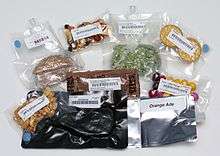
There are several classifications for food that is sent into space:[4][39]
- Beverages (B) - Freeze dried drink mixes (coffee or tea) or flavored drinks (lemonade or orange drink) are provided in vacuum sealed beverage pouches. Coffee and tea may have powdered cream and/or sugar added depending on personal taste preferences. Empty beverage pouches are provided for drinking water.
- Fresh Foods (FF)- Fresh fruit, vegetables and tortillas delivered by resupply missions. These foods spoil quickly and need to be eaten within the first two days of flight to prevent spoilage. These foods are provided as psychological support.
- Irradiated (I) Meat - Beef steak that is sterilized with ionizing radiation to keep the food from spoiling. NASA has dispensation from the U.S. Food and Drug Administration (FDA) to use this type of food sterilization.
- Intermediate Moisture (IM) - Foods that have some moisture but not enough to cause immediate spoilage.
- Natural Form (NF) - Commercially available, shelf-stable foods such as nuts, cookies and granola bars that are ready to eat.
- Rehydratable (R) Foods - Foods that have been dehydrated by various technologies (such as drying with heat, osmotic drying and freeze drying) and allowed to rehydrate in hot water prior to consumption. Reducing the water content reduces the ability of microorganisms to thrive.
- Thermostabilized (T) - Also known as the retort process. This process heats foods to destroy pathogens, microorganisms and enzymes that may cause spoilage.
- Extended shelf-life bread products - Scones, waffles and rolls specially formulated to have a shelf life of up to 18 months.
More common staples and condiments do not have a classification and are known simply by the item name:
Consumer derivatives
Capitalizing on the popularity of the Apollo space missions, Pillsbury marketed "Food Sticks" (also known as "Space Food Sticks") for the consumer market in the early 1970s.[40] Fourteen individually packaged sticks were included in a box, and came in six flavors such as peanut butter, caramel, and chocolate. Food Sticks were marketed as a "nutritionally balanced between meal snack".
Most of these products can now be found in NASA Space Center gift shops, general novelty shops or at Army Surplus stores. A popular example is freeze-dried ice cream. Campers have taken to using products such as Tang due to their reliability, but some others, such as many of the freeze dried foods, contain fragrances that can attract bears, cougars, and other forest animals.
Tang, originally marketed in 1959, also saw an increase in popularity during this era due to its inclusion on the manned space flights.
See also
References
- ↑ Working Group on Nutrition and Feeding Problems. The National Academies Press. April 1963. doi:10.17226/12419.
- ↑ Glenday, Craig, ed. (2012). Guinness World Records 2013. Guinness World Records. p. 27. ISBN 9781904994879.
- 1 2 Lane, Helen W.; Feeback, Daniel L. (October 2002). "History of nutrition in space flight". Nutrition. 18 (10): 797–804. doi:10.1016/S0899-9007(02)00946-2.
- 1 2 3 4 NASA (2002-04-07). "Food For Space Flight". Fact Sheet Library. Retrieved 2006-12-12.
- ↑ Evans, Ben, "Why Postpone a Success?" The Days Before Freedom 7, AmericaSpace, LLC
- ↑ Voice Transcript of GT-3, p. 45 NASA.gov
- ↑ Detailed Biographies of Apollo I Crew - Gus Grissom NASA.gov
- ↑ Gemini III Fact Sheet Spaceline.org
- ↑ De Groot, Gerard. Dark Side of the Moon: The Magnificent Madness of the American Lunar Quest. (NYU Press, 2006), p.190
- 1 2 3 Aldrin, Buzz (14 July 2014). "Guideposts Classics: Buzz Aldrin on Communion in Space". Guideposts. Retrieved 23 March 2018.
- 1 2 3 4 Benson, Charles Dunlap and William David Compton. Living and Working in Space: A History of Skylab. NASA publication SP-4208.
- 1 2 3 Ross-Nazzal, Jennifer (7 April 2006). "Edited Oral History Transcript - Charles T. Bourland". NASA Johnson Space Center Oral History Project.
- 1 2 Belew, Leland. (editor) Skylab, Our First Space Station NASA publication SP-400.
- ↑ "Living It Up in Space" Time, 25 June 1973.
- ↑ Former Astronaut Recalls Historic Apollo-Soyuz Mission NASA
- ↑ "About Us". Institute of Cryobiology and Food Technology. Retrieved 15 June 2017.
- ↑ Burgess, Colin; Vis, Bert (2016). Interkosmos: The Eastern Bloc's Early Space Program. Springer-Praxis. p. 249. doi:10.1007/978-3-319-24163-0. ISBN 978-3-319-24161-6.
- ↑ Prohazkova, Yaroslava (9 April 2011). "В Космоса: яденето българско, сексът руски" [In the Cosmos: Eating Bulgarian, Russian Sex]. 24chasa.bg (in Bulgarian). Retrieved 15 June 2017.
- ↑ Vassileva, Silvia (19 April 2015). "У нас е първата оранжерия за космическа храна в света" [In our country is the first greenhouse for space food in the world]. Delo.bg (in Bulgarian). Retrieved 15 June 2017.
- ↑ "杨利伟的10月15日:飞船中的"非常"生活". Retrieved 8 October 2014.
- ↑ "Chinese astronaut food to hit market shelves". Retrieved 8 October 2014.
- ↑ "China-made space food for astronauts on display". Retrieved 8 October 2014.
- ↑ Povoledo, Elisabetta (4 May 2015). "Espresso? Now the International Space Station Is Fully Equipped". The New York Times. Retrieved 7 May 2015.
- ↑ Pearlman, Robert Z. (4 May 2015). "To boldly brew: Astronaut uses ISSpresso to make first cup of coffee in space". CollectSpace.com. Retrieved 7 May 2015.
- ↑ "Space Coffee - NASA Science". science.nasa.gov. Retrieved 2015-07-11.
- ↑ 「宇宙日本食」の認証について, Japan Aerospace Exploration Agency (JAXA), 2007
- ↑ 宇宙日本食, 2010
- ↑ Starship Kimchi: A Bold Taste Goes Where It Has Never Gone Before
- ↑ "Pravda: Healthy diet of Russian cosmonauts ruins NASA's space toilets". English pravda.ru. Retrieved 8 October 2014.
- ↑ "Christer Fuglesang redo för rymden efter 14 års träning" (in Swedish). Archived from the original on 2007-10-01. Retrieved 2006-11-19.
- ↑ "Torkat renkött störde julfriden" (in Swedish). Sydsvenska dagbladet. Archived from the original on 2009-01-20.
- ↑ "NASA - Human Systems Engineering and Development (HSED) - HRP Advanced Food Technology". Archived from the original on 22 September 2014. Retrieved 8 October 2014.
- 1 2 Kloeris, Vickie (May 1, 2001). "Eating on the ISS". Field Journal. NASA. Archived from the original on September 30, 2006.
Because there is no gravity, the contents of your stomach float and tend to stay at the top of your stomach, under the rib cage and close to the valve at the top of your stomach. Because this valve isn't a complete closure (just a muscle that works with gravity), if you burp, it becomes a wet burp from the contents in your stomach.
- ↑ Connelly, Claire (March 1, 2011). "How does space beer taste? It's out of this world..." News.com.au. News Corp Australia.
- ↑ Mason, Betsy (December 8, 2009). "Barley + Space = Space Beer!". Wired.
- ↑ Szondy, David (June 3, 2012). "How to bake bread in space". New Atlas. Retrieved May 9, 2018.
- 1 2 Bourland, Charles (2001) Packaging foods for flight— NASA FTCSC News, July 2001
- ↑ Lu, Edward (2003) Expedition 7: Eating at Cafe ISS, Greetings Earthlings:Ed's musings from space,
- ↑ Perchonok, M; Douglas, G; Cooper, M (2009). "Risk of Performance Decrement and Crew Illness Due to an Inadequate Food System". In McPhee, J; Charles, J. Human health and performance risks of space exploration missions : evidence reviewed by the NASA Human Research Program (PDF). Johnson Space Center, Houston: National Aeronautics and Space Administration, Lyndon B. Johnson Space Center. pp. 4–5. ISBN 978-0160846342.
- ↑ "Space Food Sticks". Retrieved 8 October 2014.
External links
| Wikimedia Commons has media related to Space food. |
- Space food by NASA Human Spaceflight
- Space food fact sheets by NASA
- Aerospace Food Technology (1969) by NASA
- Dining on the Space Station on YouTube by NASA/Scott Kelly
- "Beyond Tang: Food in Space" by NPR
